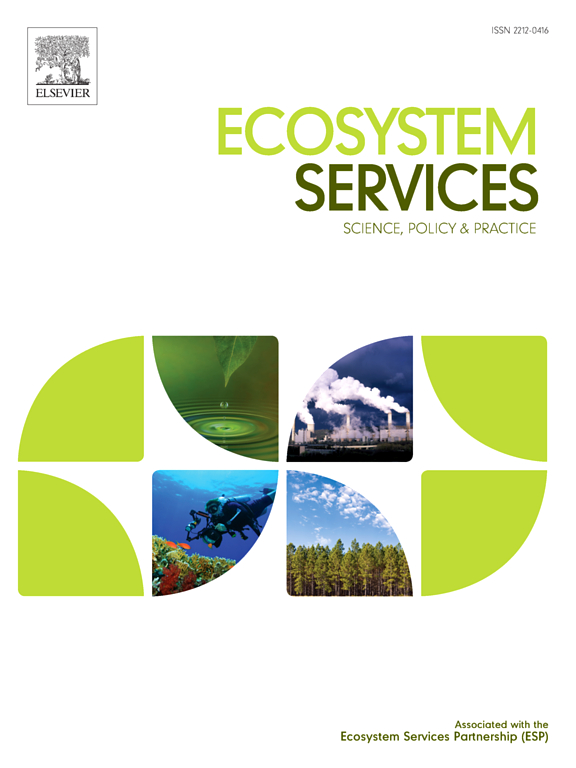Integration of the system of environmental economic accounting-ecosystem accounting (SEEA-EA) framework with a semi-distributed hydrological and water quality simulation model
IF 6.6
2区 环境科学与生态学
Q1 ECOLOGY
引用次数: 0
Abstract
This research is aimed to map the ecosystem accounting according to the System of Environmental-Economic Accounting-Ecosystem Accounting (SEEA-EA) framework in river-basin scale, while examining the potential of the Soil and Water Assessment Tool (SWAT) in drawing the ecosystem accounting. The focus of the accounting is on the physical ecosystem extent (EEA), condition (ECA), and services (ESA) in the Karaj River-basin, Iran. To analyze the EEA, we attributed the ecosystems based on the Global Ecosystem Typology developed by the International Union for Conservation of Nature (IUCN). Then, the attribute tables of each sub-basin were processed in ArcMap environment to quantify the changes between 2005 and 2010. SWAT model of the study area was calibrated and validated based on hydrological and water quality data to evaluate the ECA and ESA. Furthermore, we assessed the water supply for different purposes among the ecosystem services by employing the SWAT model. This research determined the contribution of water provision by the ecosystem to various uses and beneficiaries, and evaluated the trends and attribution of the changes.
Concerning terrestrial accounts in EEA, the T6.4 (Grassland) ecosystem reduction was the most significant change observed. Also, unmanaged expansions emerged as the predominant factor contributing to changes across various ecosystems. Reviewing the ECA revealed that the T3.2 (Shrubland), T6.4, and T5.1 (Bareland) ecosystems have experienced area reductions of 19.2%, 18.2%, and 8%, respectively, while the T7.3 (Orchard) and F1.1 (Freshwater) ecosystems exhibited approximately 9% and 6% increases in condition. The analysis of the ECA indicated that the decrease in precipitation, particularly snowfall, is the main contributing factor to the deteriorating condition of the terrestrial ecosystems. The examination on the EEA demonstrated a decline in the water supplied by the ecosystems. The findings indicate that incorporating the SWAT model within an ecosystem accounting framework, offers valuable insights to facilitate informed decision-making.

将环境经济核算体系-生态系统核算(SEEA-EA)框架与半分布式水文和水质模拟模型相结合
本研究旨在根据环境经济核算体系-生态系统核算(SEEA-EA)框架,绘制河流流域范围内的生态系统核算图,同时检验土壤与水评估工具(SWAT)在绘制生态系统核算图方面的潜力。核算的重点是伊朗卡拉季河流域的物理生态系统范围(EEA)、状况(ECA)和服务(ESA)。为了分析 EEA,我们根据世界自然保护联盟(IUCN)制定的全球生态系统类型学对生态系统进行了归类。然后,在 ArcMap 环境中处理了每个子流域的属性表,以量化 2005 年至 2010 年间的变化。根据水文和水质数据对研究区域的 SWAT 模型进行了校准和验证,以评估 ECA 和 ESA。此外,我们还利用 SWAT 模型评估了生态系统服务中不同用途的供水情况。这项研究确定了生态系统为各种用途和受益者提供的水量,并评估了变化趋势和归因。关于 EEA 中的陆地账户,T6.4(草地)生态系统的减少是观察到的最显著变化。此外,无管理的扩张也是导致各种生态系统变化的主要因素。回顾 ECA 发现,T3.2(灌木林)、T6.4 和 T5.1(裸地)生态系统的面积分别减少了 19.2%、18.2% 和 8%,而 T7.3(果园)和 F1.1(淡水)生态系统的状况则分别增加了约 9% 和 6%。对 ECA 的分析表明,降水量(尤其是降雪量)的减少是导致陆地生态系统状况恶化的主要因素。对 EEA 的研究表明,生态系统的供水量下降。研究结果表明,将 SWAT 模型纳入生态系统核算框架可为促进知情决策提供有价值的见解。
本文章由计算机程序翻译,如有差异,请以英文原文为准。
求助全文
约1分钟内获得全文
求助全文
来源期刊

Ecosystem Services
ECOLOGYENVIRONMENTAL SCIENCES&-ENVIRONMENTAL SCIENCES
CiteScore
14.90
自引率
7.90%
发文量
109
期刊介绍:
Ecosystem Services is an international, interdisciplinary journal that is associated with the Ecosystem Services Partnership (ESP). The journal is dedicated to exploring the science, policy, and practice related to ecosystem services, which are the various ways in which ecosystems contribute to human well-being, both directly and indirectly.
Ecosystem Services contributes to the broader goal of ensuring that the benefits of ecosystems are recognized, valued, and sustainably managed for the well-being of current and future generations. The journal serves as a platform for scholars, practitioners, policymakers, and other stakeholders to share their findings and insights, fostering collaboration and innovation in the field of ecosystem services.
 求助内容:
求助内容: 应助结果提醒方式:
应助结果提醒方式:


